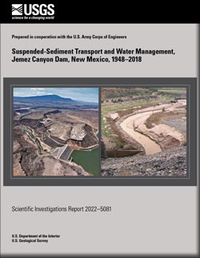Suspended-Sediment Transport and Water Management, Jemez Canyon Dam, New Mexico, 1948–2018
Links
- Document: Report (2.01 MB pdf) , HTML , XML
- Datasets:
- USGS Earth Resources Observation and Science Center database —EarthExplorer
- USGS National Water Information System database —USGS water data for the Nation
- Download citation as: RIS | Dublin Core
Abstract
Construction and operation of dams provide sources of clean drinking water, support large-scale irrigation, generate hydroelectricity, control floods, and improve river navigation. Yet these benefits are not without cost. Dams affect the natural flow regime, downstream sediment fluxes, and riverine and riparian ecosystems. The Jemez Canyon Dam in New Mexico was constructed in 1953 by the U.S. Army Corps of Engineers with authorizations for flood control and sediment retention. Water managers of the dam use various operational techniques to restore peak streamflow, improve sediment management, and restore altered ecosystem processes, while maintaining the authorized purposes of the dam. This study focuses on four distinct reservoir management operation periods implemented at the Jemez Canyon Dam: (1) predam (pre-1953), (2) a seasonal 24-hour hold pool (1953–79), (3) a permanent pool (1979–2001), and (4) dry reservoir (2001–18).
Results of this study indicate successful flood control and reduction in peak instantaneous streamflow events following construction of the dam, specifically documented in 1958 and 2013. During the second water management operation period, moderate sediment retention (also defined as trap efficiency, which is the percentage of incoming sediments trapped within a reservoir during a given time) occurred (between 41.0 and 67.0 percent of sediments were retained). During the third period (1979–2001), between 61.2 and 99.8 percent of sediments were retained. During the fourth period (2001–18), at least 1,909 acre-feet of accumulated sediment were remobilized. The estimated dam trap efficiency during the fourth water management operation period was −37.2 percent, indicating that more sediments were being removed from the Jemez Canyon Reservoir than were being deposited. These remobilized sediments supplemented the natural sediment delivery in the Jemez River to the middle Rio Grande. The current (2022) dry reservoir operation allows sediment delivery during periods when flooding is not a concern while still providing flood control when needed.
Suspended-sediment particle size data indicate potential coarsening of suspended sediments during the fourth water management operation period, likely resulting from erosion of coarse bed sediments deposited in the reservoir. Suspended-sediment particle size data during the first and fourth water management operation periods indicate that finer sediment mobilized during monsoon season than during snowmelt. Also, suspended-sediment concentrations during the predam and post-hold pool periods indicate concentrations were higher during monsoon season than during snowmelt. Seasonal variations in suspended-sediment concentration and particle size may help dam managers make operational decisions by increasing the understanding of particle size, concentration, and variation of suspended sediment during a given year. The seasonality of suspended-sediment transport can also vary, depending not only on concentration and particle size, but on precipitation. The maximum annual suspended-sediment loads occurred during all three seasonal categories analyzed in this study: snowmelt, monsoon, and the remainder of the year. This indicates that, in addition to sediment particle size and concentration, understanding the variability of transport mechanisms of suspended-sediment load can also guide optimal water management operations at a dam.
Suggested Citation
Brown, J.E., Matherne, A.M., Reale, J.K., and Miltenberger, K.E., 2022, Suspended-sediment transport and water management, Jemez Canyon Dam, New Mexico, 1948–2018: U.S. Geological Survey Scientific Investigations Report 2022–5081, 30 p., https://doi.org/10.3133/sir20225081.
ISSN: 2328-0328 (online)
ISSN: 2328-031X (print)
Study Area
Table of Contents
- Acknowledgments
- Abstract
- Introduction
- Methods of Investigation
- Results
- Discussion
- Summary
- References Cited
| Publication type | Report |
|---|---|
| Publication Subtype | USGS Numbered Series |
| Title | Suspended-sediment transport and water management, Jemez Canyon Dam, New Mexico, 1948–2018 |
| Series title | Scientific Investigations Report |
| Series number | 2022-5081 |
| ISBN | 978-1-4113-4481-5 |
| DOI | 10.3133/sir20225081 |
| Publication Date | November 08, 2022 |
| Year Published | 2022 |
| Language | English |
| Publisher | U.S. Geological Survey |
| Publisher location | Reston, VA |
| Contributing office(s) | New Mexico Water Science Center |
| Description | Report: vii, 30 p.; 2 Datasets |
| Country | United States |
| State | New Mexico |
| Other Geospatial | Jemez Canyon Dam |
| Online Only (Y/N) | N |


